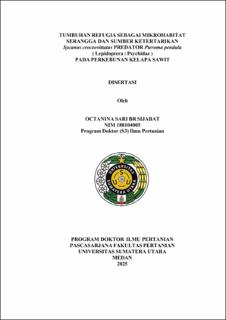Tumbuhan Refugia sebagai Mikrohabitat Serangga dan Sumber Ketertarikan Sycanus croceovittatus Predator Pteroma pendula (Lepidoptera: Psychidae) pada Perkebunan Kelapa Sawit
Refugia Plants as Microhabitat Insects and Sources of Interest Sycanus croceovittatus Predator of Pteroma pendula (Lepidoptera: Psychidae) on Oil Palm Plantations

Date
2025Author
Sijabat, Octanina Sari Br
Advisor(s)
Purba, Edison
Marheni, Marheni
Rahmawati, Nini
Metadata
Show full item recordAbstract
Octanina Sari Br Sijabat conducted a study en titled “Refugia plants as microhabitat insects and sources of interest Sycanus croceovittatus predator of Pteromapendula (Lepidoptera: Psychidae) on oil palm plantations” The dissertationwasguided by the promotors Prof. Ir. Edison Purba, Ph.D, Prof. Dr. Ir. Marheni, M.P and Dr. Nini Rahmawati, S.P., M.Si. Pteroma pendula is a type of bagworm that attacks oil palmplantations inIndonesia. The control carried out so far in oil palm plantations is by usingpesticides so that it can reduce the predator population. One alternative pest
control that can be implemented is biological control by utilizing controllingfactors that already exist in nature. The existence of vegetation that has thepotential to become refugia on plantation land is also important because floweringrefugia can be used by predatory insects to provide shelter, a source of foodandnutrition as well as a breeding ground for insects. This is important because wildplants flower around oil palm plantations as a natural stimulant to attract
populations of natural pest pests. The research consists of two phases, the first
phase is Visual observation and identification of insects present on refugia plants;
Phase II Testing volatile compounds and testing refugia as a micro-habitat for
predators of P. pendula pests ; phase III Study of Growth and Development of
Refugia under Differences in Light Intensity. The results of the first phaseof
research showed that several types of insects were present in the refugia, namelyAllamanda athartica, Clitoria ternatea, Turnera ulmifolia, Caesalpiniapulcherrima, Antigonon leptosus, Cassia tora, Clotaria retusa, Clotaria pallidawith different levels of diversity from low to medium. This is expected to obtainrefugia species that are potential food sources and become a source of attractionfor the predator Pteroma pendula. The results of the second phase of researchtesting volatile compounds using GC_MS analysis showed that the content of
different compounds in each refugia tested was Turnera ulmifolia 19 compounds, Antigonon leptosus 7 compounds, Cassia tora 25 compounds, Clotaria retusa14compounds, Clotaria pallida 26 compounds. Various types of compoundsidentified as having a source of attraction for predatory insects include methyl
linolenate which acts as a plant metabolite or insect attractant. Tests of predator
attraction to refugia showed that predatory insects were very attracted toT. ulmifolia and A. leptosus because they flowered all year round and had bright
yellow and pink colors. The results of the third stage of research: the influenceof
sunlight greatly influences the number of flowers that bloom and the number of
flowers that fall on T. ulmifolia and A. leptosus plants as a source of predator
attraction.
